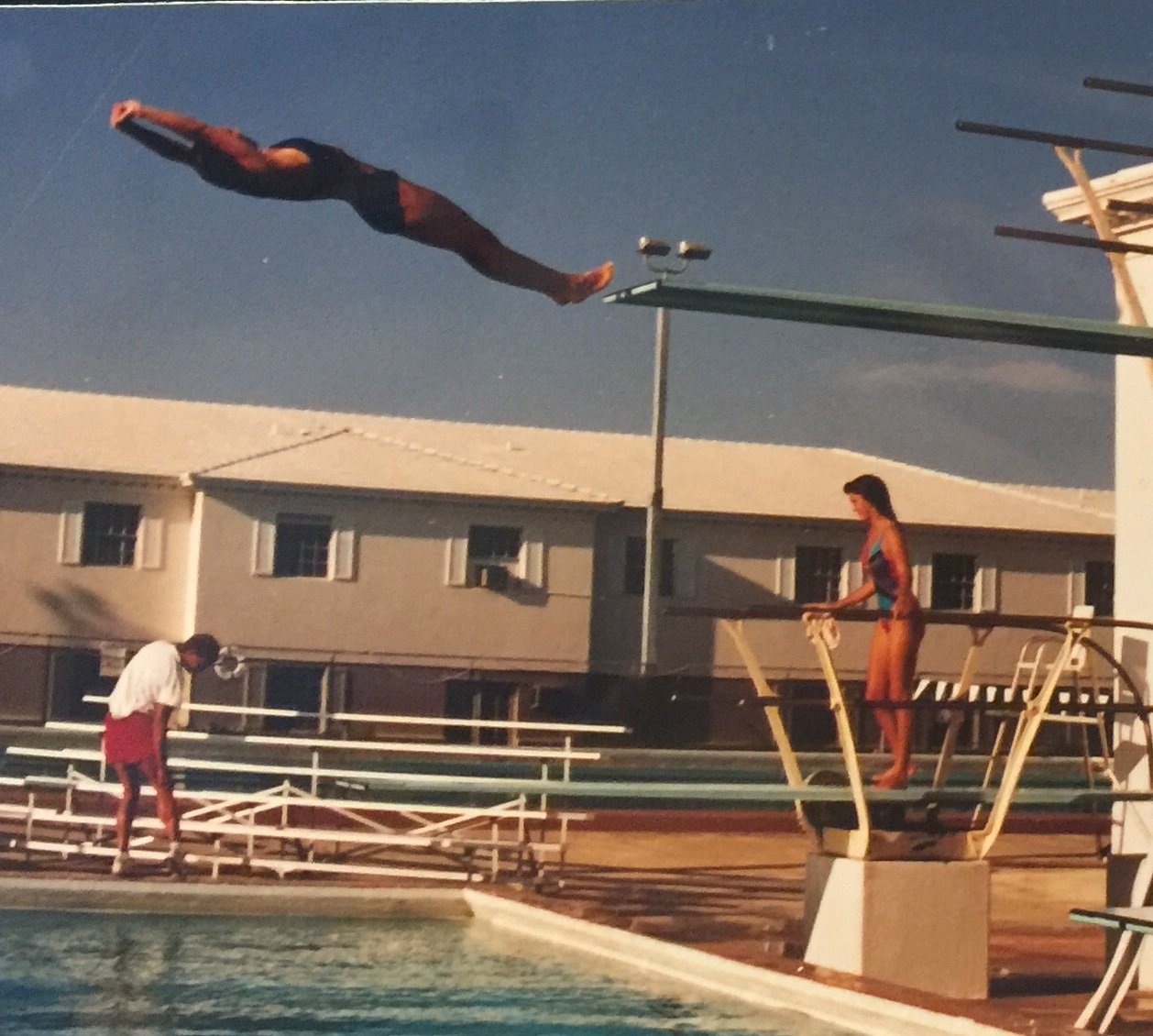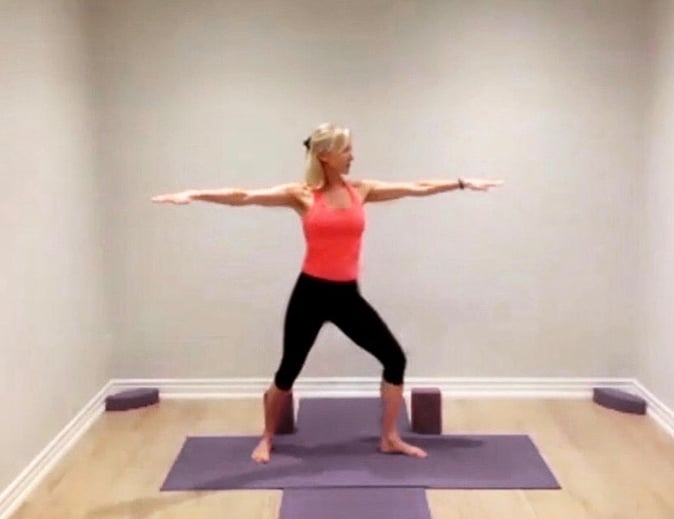Spending her senior year at Pine Crest, Jill Cressy ’91 has fond memories of her time diving and pursuing her studies.
Transferring to Pine Crest after living in Connecticut from grades five to 11, Jill remembers falling in love with the School right away.
“I fell in love with Pine Crest the first time we looked at it,” she said. “I loved the pool, and ended up joining the varsity diving team. Diving was definitely one of my favorite memories. To train, I would get on a trampoline and harness to simulate the movement I would be doing on the diving board. As a former competitive gymnast, it was fun to create that movement in a safe way and to be outside in the sunshine. It was great to train outdoors, look up at the sky and feel the warmth of the sun.”
“Diving provided a healthy break between my academics, as I was very focused on my school work and applying to colleges and universities,” said Jill. “I give a lot of credit to Pine Crest and my advisor Mrs. Marcia Hunt ’12H. I remember Mrs. Hunt was very helpful when I was going through the application process for universities and colleges. I was accepted at a high number of places and it was great to have so many options to choose from.”
Born in Toronto, Canada, Jill decided to attend the University of Toronto. As a student working toward her Bachelor of Physical and Health Education, she stayed active by playing varsity lacrosse, coaching gymnastics, teaching fitness, and performing in dance shows. She also completed her Master of Education (MEd) there and worked in administrative leadership positions with the University of Toronto Faculty of Kinesiology & Physical Education, managing co-curricular physical activity programs including fitness, dance, sport, movement, yoga, and mindfulness classes. 
“I have always loved physical activity,” said Jill. “I valued my time as a diver, I used to dance at a studio close to the Pine Crest campus, and I also liked to run. As a child, I was a competitive gymnast. I also played field hockey and lacrosse in Connecticut. While working toward my MEd, I wrote a research paper on the roles of physical activity and health in enhancing student engagement with implications for leadership. My paper was published and I continue to value the role of physical activity for creating a sense of community, belonging, mental health, and well-being.
Reflecting on the multiculturalism of Toronto, Jill believes including different perspectives has made her a better mindfulness coach and practitioner.
“Living in Toronto has helped to widen my lens and gain an appreciation for different perspectives. It has also taught me to take time to listen to viewpoints other than my own,” said Jill. “I think listening to different perspectives can help us make better decisions when we work with teams — considering multiple frames of reference requires mindful awareness. We need to recognize that no one person can solve the world’s problems. In the same way, one individual can’t have the expertise to provide solutions for the problems that the entire organization is facing. The complexity of challenges in our world requires consideration of a diversity of perspectives.”
Making the connection between cultural competency and mindfulness, Jill continued by saying that “mindfulness students are taught to pay attention on purpose, in the present moment, and in a non-judgemental way. Technically speaking, mindfulness is what arises when we pay attention, on purpose, in the moment. It places emphasis on our own awareness and prevents us from being on autopilot. For example, if we are aware of our posture when we type on our computer we are more likely to breathe better, relax our shoulders, unclench our hands and prevent ourselves from tensing up as we work. In turn, this awareness helps us focus, think better, prevent anxiety, and be more productive. When we focus on the here and now, it keeps us from dwelling on the past or worrying about the future.”
As mindfulness practices grow in popularity, Jill believes that finding an activity you enjoy and sticking with it will help you gain the benefits of these practices in your everyday life.  Jill teaches yoga virtually during the COVID-19 global pandemic.
Jill teaches yoga virtually during the COVID-19 global pandemic.
“With yoga, for example, it’s become so trendy, but at the same time, even if people go because it’s trendy, it still has benefits,” said Jill. “If people learn to be more aware of their thoughts, feelings, posture, and notice the environment around them, then it will be easier for them to stay in the moment, appreciate the feeling of being present, and integrate that practice into their daily lives.”
“In the workshops I lead, I teach the difference between a dedicated practice and an integrated practice,” said Jill. “An example of a dedicated practice is setting aside time for a yoga or meditation class or a short breath awareness practice. An integrated practice is applying mindfulness throughout the day with colleagues, friends, and family. For example, we practice mindful listening by staying engaged and present with the person we are listening to. This allows us to really hear what they are saying, and also forces us to pay attention to our own body language by remaining non-judgmental and open to the conversation. The same goes for mindful speaking — staying aware of our voice tone, body language, and how we are affecting the other person, while also recognizing their facial expressions or gestures. Practicing mindfulness with curiosity and free of judgment helps us open up to different perspectives, and this, in turn, helps us think more critically, challenge our assumptions and explore alternative approaches and solutions.”
Jill encourages these practices in our professional lives as well. “Stay present in communication when it is one-on-one or in a group conversation. In a boardroom, be aware of who is speaking, but also who is not speaking. Who is not at the table? What voices are not represented here? Who is at the table but not sharing their input? If I am chairing the meeting, then I would make an effort to engage that person and make them feel comfortable to share their input. We need to create safer spaces where everyone feels welcome and included. That goes back to widening the lens — not just looking at the person speaking but noticing the other people at the table and expanding our vision to see everyone, making sure more people are comfortable contributing to the exchange.”
As Jill continues, she expresses the importance of this type of present communication for fostering an environment where all people feel seen and heard, particularly against the backdrop of adversity and working through challenges. For example, the COVID-19 global pandemic has caused many people to deal with increased levels of stress and anxiety. In managing stress and anxiety, Jill recommends listening to your body and showing yourself compassion.
“In my wellness coaching, I remind people to listen to their bodies,” said Jill. “If they are looking at a computer screen all day long, it’s important to take breaks from our Zoom focus and look out into the distance every so often to relax our eyes. Taking breaks, eating a snack, and staying hydrated are important in terms of listening to our bodies. For anyone who checks their emails late at night, that can affect the ability to fall asleep and stay asleep. I recommend everyone turn off their electronic devices half an hour before going to sleep, and put their cell phones in a different space, away from the bedroom.”
“Practicing compassion with ourselves and others is the key to surviving this pandemic, especially for those of us who are high-achievers,” she said. “Some of us have learned to give ourselves a bit more grace and realize we can’t do as much, or that we need to take more breaks. I have heard that people are now slower to reply to text messages, phone calls, or emails, or don’t reply at all. We don’t know what everyone is going through, so don’t take it personally if a friend or colleague doesn’t reply in what you perceive as a timely manner. People are setting more boundaries for themselves, particularly because so many have and still are experiencing ‘COVID fatigue.’ So if someone is slow to reply to a text, it is important to acknowledge that this has been a difficult time for many across the world.”
Jill goes on to explain that while the pandemic has presented challenges and hardships for many of us, this “new normal” has also created favorable conditions for many to re-examine how they navigate their personal and professional lives.
For anyone embarking on a new career path, Jill recommends staying open to different opportunities. “If we are too specific on how we feel our lives should look, it can set us up for disappointment,” she said. “There are always options and opportunities, and we can open up to see the range of alternatives. In our careers and in our lives, there is never just one way — there are different paths and we have choices for each step along the way.”
